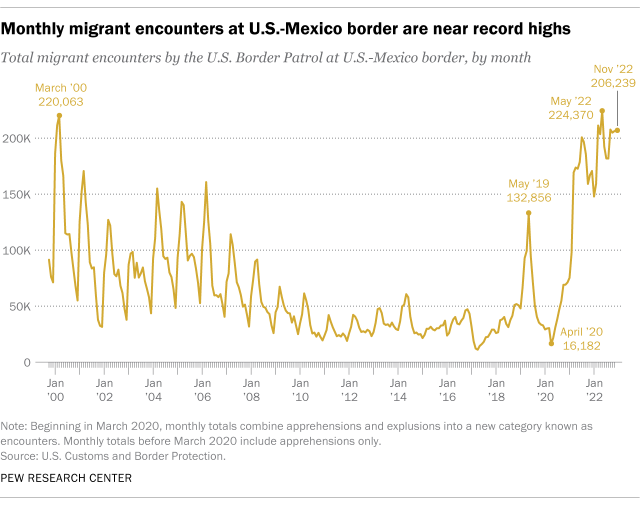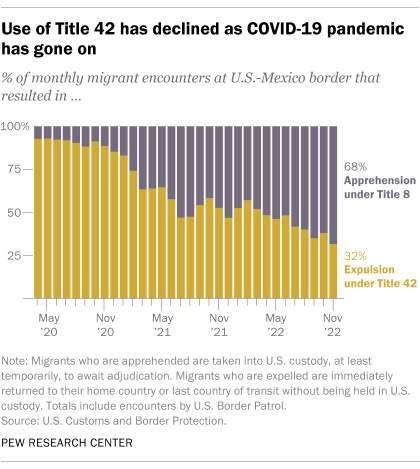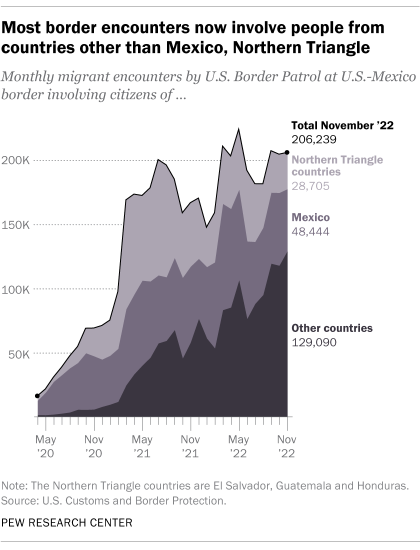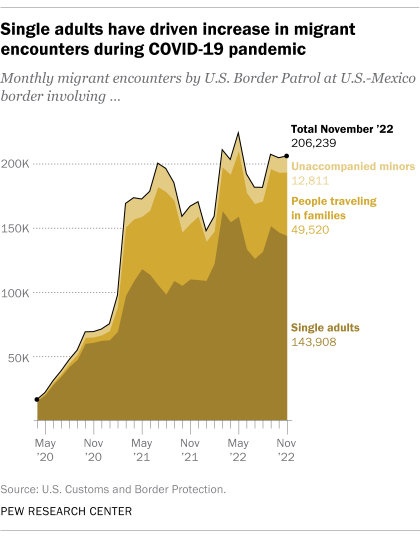Monthly encounters between U.S. Border Patrol agents and migrants attempting to cross into the United States at the U.S.-Mexico border remain at levels not seen in more than two decades, according to the latest available government statistics. The recent influx of migrants at the southwestern border has been a key topic of discussion this week in meetings between U.S. President Joe Biden and his Mexican counterpart, Andrés Manuel López Obrador.
The number of monthly migrant encounters had fallen to 16,182 – the second-lowest total in more than 20 years – in April 2020, shortly after the coronavirus outbreak forced the closure of the southwestern border and slowed migration across much of the world.
But encounters with migrants at the U.S.-Mexico border have soared since then, with 206,239 reported in November 2022, according to the latest available monthly data from U.S. Customs and Border Protection (CBP), the federal agency that encompasses the Border Patrol. Recent monthly totals far exceed the peak reached during the last major wave of migration at the U.S.-Mexico border in May 2019 and are roughly on par with the previous peak reached in March 2000.

This Pew Research Center analysis examines current and historical data from U.S. Customs and Border Protection (CBP) to assess how migration patterns at the U.S.-Mexico border have changed over time. The analysis is based on a metric known as monthly migrant encounters.
Encounters encompass two distinct kinds of events: apprehensions, in which migrants are taken into custody in the United States – at least temporarily – to await adjudication, and expulsions, in which migrants are immediately expelled to their home country or last country of transit without being held in U.S. custody. CBP began publishing data on migrant encounters in March 2020, when expulsions began under a public health order called Title 42. In this analysis, all references to migrant encounters prior to March 2020 refer to apprehensions only.
It is important to note that encounters refer to events, not people, and that some migrants are encountered more than once. As a result, the overall number of encounters reported in a given month may overstate the number of distinct individuals involved.
This analysis only includes monthly encounters reported by the Border Patrol. It excludes encounters reported by the Office of Field Operations.
Migrant encounters refer to two distinct kinds of events:
- Apprehensions. Migrants are taken into custody in the United States – at least temporarily – to await adjudication. Apprehensions are carried out under Title 8 of the U.S. code, which deals with immigration law.
- Expulsions. Migrants are immediately expelled to their home country or last country of transit without being held in U.S. custody. Expulsions are carried out under Title 42 of the U.S. code, a previously rarely used section of the law that was invoked by the Trump administration during the early stages of the coronavirus pandemic. The law empowers federal health authorities to stop migrants from entering the country if it is determined that doing so could prevent the spread of contagious diseases.

In the first months of the COVID-19 pandemic in the U.S., the Border Patrol relied heavily on Title 42 to expel most of the migrants it encountered at the border. But that pattern has shifted more recently under the Biden administration. In November 2022, about two-thirds of all migrant encounters (68%) ended in apprehension under Title 8, while around a third (32%) resulted in expulsion under Title 42.
As the coronavirus pandemic has gone on, there has also been a notable shift in the origin countries of migrants crossing into the U.S. at the southwestern border.

In April 2020, in the first weeks of the U.S. coronavirus outbreak, people from Mexico and the Northern Triangle countries of El Salvador, Guatemala and Honduras accounted for the vast majority of those encountered at the border. But that is no longer the case: In November 2022, a majority of the migrants encountered at the border (63%) were from countries other than Mexico and the Northern Triangle region.
Some of the biggest increases in encounters have involved people from Colombia, Cuba, Nicaragua, Peru and Venezuela. For example, there were only four encounters with Colombian nationals at the U.S.-Mexico border in April 2020. By November 2022, that figure had increased to 15,439. There were even steeper increases in encounters with migrants from Cuba (from 161 encounters in April 2020 to 34,639 in November 2022) and Nicaragua (from 86 to 34,162). The number of encounters involving people from Peru rose from 18 in April 2020 to 8,495 in November 2022. And while the number of encounters with Venezuelans has decreased in recent months, it remains far above the levels recorded in the early months of the pandemic.

When it comes to the demographic profile of those crossing the border, single adults have accounted for most of the recent increase in encounters. Seven-in-ten encounters in November 2022 involved single adults, while far smaller shares involved families (24%) or unaccompanied minors (6%). Still, the percentage of encounters involving families has risen sharply during the pandemic.
Note: This is an update of a post originally published on March 15, 2021.



